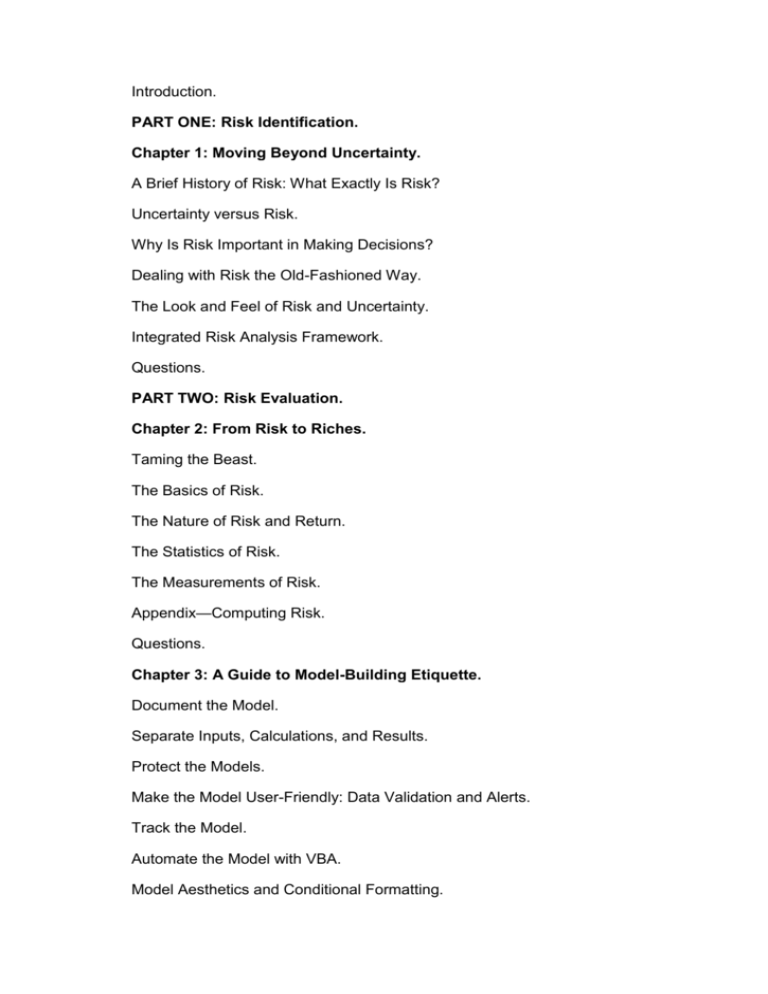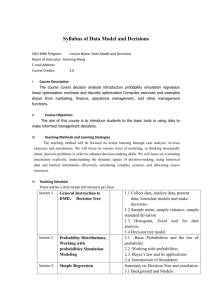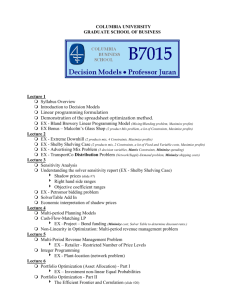Introduction
advertisement

Introduction. PART ONE: Risk Identification. Chapter 1: Moving Beyond Uncertainty. A Brief History of Risk: What Exactly Is Risk? Uncertainty versus Risk. Why Is Risk Important in Making Decisions? Dealing with Risk the Old-Fashioned Way. The Look and Feel of Risk and Uncertainty. Integrated Risk Analysis Framework. Questions. PART TWO: Risk Evaluation. Chapter 2: From Risk to Riches. Taming the Beast. The Basics of Risk. The Nature of Risk and Return. The Statistics of Risk. The Measurements of Risk. Appendix—Computing Risk. Questions. Chapter 3: A Guide to Model-Building Etiquette. Document the Model. Separate Inputs, Calculations, and Results. Protect the Models. Make the Model User-Friendly: Data Validation and Alerts. Track the Model. Automate the Model with VBA. Model Aesthetics and Conditional Formatting. Appendix—A Primer on VBA Modeling and Writing Macros. Exercises. PART THREE: Risk Quantification. Chapter 4: On the Shores of Monaco. What Is Monte Carlo Simulation? Why Are Simulations Important? Comparing Simulation with Traditional Analyses. Using Risk Simulator and Excel to Perform Simulations. Questions. Chapter 5: Test Driving Risk Simulator. Getting Started with Risk Simulator. Running a Monte Carlo Simulation. Using Forecast Charts and Confidence Intervals. Correlations and Precision Control. Appendix—Understanding Probability Distributions. Questions. Chapter 6: Pandora’s Toolbox. Tornado and Sensitivity Tools in Simulation. Sensitivity Analysis. Distributional Fitting: Single Variable and Multiple Variables. Bootstrap Simulation. Hypothesis Testing. Data Extraction, Saving Simulation Results, and Generating Reports. Custom Macros. Appendix—Goodness-of-Fit Tests. Questions. PART FOUR: Industry Applications. CHAPTER 7: Extended Business Cases I: Pharmaceutical and Biotech Negotiations, Oil and Gas Exploration, Financial Planning with Simulation, Hospital Risk Management, and Risk-Based Executive Compensation Valuation. Case Study: Pharmaceutical and Biotech Deal Structuring. Case Study: Oil and Gas Exploration and Production. Case Study: Financial Planning with Simulation. Case Study: Hospital Risk Management. Case Study: Risk-Based Executive Compensation Valuation. PART FIVE: Risk Prediction. Chapter 8: Tomorrow’s Forecast Today. Different Types of Forecasting Techniques. Running the Forecasting Tool in Risk Simulator. Time-Series Analysis. Multivariate Regression. Stochastic Forecasting. Nonlinear Extrapolation. Box–Jenkins ARIMA Advanced Time-Series. Questions. Chapter 9: Using the Past to Predict the Future. Time-Series Forecasting Methodology. No Trend and No Seasonality. With Trend but No Seasonality. No Trend but with Seasonality. With Seasonality and with Trend. Regression Analysis. The Pitfalls of Forecasting: Outliers, Nonlinearity, Multicollinearity, Heteroskedasticity, Autocorrelation, and Structural Breaks. Other Technical Issues in Regression Analysis. Appendix A—Forecast Intervals. Appendix B—Ordinary Least Squares. Appendix C—Detecting and Fixing Heteroskedasticity. Appendix D—Detecting and Fixing Multicollinearity. Appendix E—Detecting and Fixing Autocorrelation. Questions. Exercise. PART SIX: Risk Diversification. Chapter 10: The Search for the Optimal Decision. What Is an Optimization Model? The Traveling Financial Planner. The Lingo of Optimization. Solving Optimization Graphically and Using Excel’s Solver. Questions. Chapter 11: Optimization Under Uncertainty. Optimization Procedures. Continuous Optimization. Discrete Integer Optimization. Appendix—Computing Annualized Returns and Risk for Portfolio Optimization. Question. Exercise. PART SEVEN: Risk Mitigation. Chapter 12: What Is So Real About Real Options, and Why Are They Optional? What Are Real Options? The Real Options Solution in a Nutshell. Issues to Consider. Implementing Real Options Analysis. Industry Leaders Embracing Real Options. What the Experts Are Saying. Criticisms, Caveats, and Misunderstandings in Real Options. Questions. Chapter 13: The Black Box Made Transparent: Real Options Super Lattice Solver Software. Introduction to the Real Options Super Lattice Solver Software. Single Asset Super Lattice Solver. Multiple Super Lattice Solver. Multinomial Lattice Solver. SLS Excel Solution. SLS Functions. Lattice Maker. PART EIGHT: More Industry Applications. Chapter 14: Extended Business Cases II: Real Estate, Banking, Military Strategy, Automotive Aftermarkets, Global Earth Observation Systems, and Employee Stock Options. Case Study: Understanding Risk and Optimal Timing in a Real Estate Development Using Real Options Analysis. Case Study: Using Stochastic Optimization and Valuation Models to Evaluate the Credit Risk of Corporate Restructuring. Case Study: Real Options and KVA in Military Strategy at the United States Navy. Case Study: Manufacturing and Sales in the Automotive Aftermarket. Case Study: The Boeing Company’s Strategic Analysis of the Global Earth Observation System of Systems. Case Study: Valuing Employee Stock Options Under the 2004 FAS 123R. PART NINE: Risk Management. Chapter 15: The Warning Signs. The Problem of Negligent Entrustment. Management’s Due Diligence. Sins of an Analyst. Reading the Warning Signs in Monte Carlo Simulation. Reading the Warning Signs in Time-Series Forecasting and Regression. Reading the Warning Signs in Real Options Analysis. Reading the Warning Signs in Optimization Under Uncertainty. Questions. Chapter 16: Changing a Corporate Culture. How to Get Risk Analysis Accepted in an Organization. Change-Management Issues and Paradigm Shifts. Making Tomorrow’s Forecast Today. Notes. Tables You Really Need. Standard Normal Distribution (partial area). Standard Normal Distribution (full area). Student’s t-Distribution (one tail and two tails). Durbin–Watson Critical Values (alpha 0.05). Normal Random Numbers. Random Numbers (multiple digits). Uniform Random Numbers. Chi-Square Critical Values. F-Distribution Critical Statistics. Real Options Analysis Values. Answers to End of Chapter Questions and Exercises. About the CD-ROM. Index.



